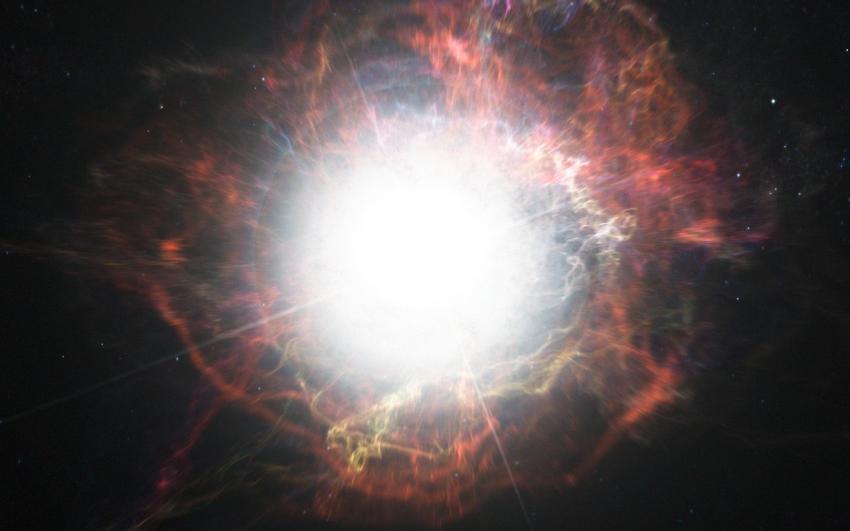New work looks at using machine learning to decipher the early stages of supernovae explosions by reconstructing the light emitted during the outburst. The research was presented today at the 2022 National Astronomy Meeting by Eleonora Parrag, a PhD student at the University of Cardiff.
The most massive dying stars can produce some of nature’s brightest fireworks: supernova explosions. These can be used to probe distances in space and answer questions about our universe, as well as producing much of the very material which makes up the world around us.
The physics governing a supernova changes in the hundreds of days past its explosion; snapshots of this physics can be captured in terms of a supernova’s spectrum – where the light is dispersed by wavelength in the way we see the colours in a rainbow. Spectra contain signatures of the elements in the explosion and can reveal the conditions involved. However, this is a limited resource. More spectra would provide important information on the ever-evolving physics surrounding supernovae and a greater ability to compare to and study their populations across cosmic time until the dawn of the universe.
Parrag’s work looks at filling in this missing information with machine learning, algorithms that learn by being ‘trained’ on existing observations of hundreds of supernovae. They can construct whole artificial spectra based on only a few data points which are easily measured from previously observed supernovae. Filling in the gaps for these existing data points then allows a spectrum to be constructed for any past explosion up to around 200 days past the explosion.
The team find that their artificial spectra reproduce many of the features seen in real supernova explosions.
Project lead Eleonora Parrag says, “Machine learning can help us find patterns and potentially even new ideas in physics in the huge amounts of data from supernovae we can observe now and in the foreseeable future.” She adds: “It's a really promising avenue to explore in astrophysics right now and I'm very excited by what we may discover about supernovae in the future!”
Further work in this area will look at applying this algorithm to all kinds of supernovae, as well as improving the algorithm and increasing the number and variety of supernovae used in training.
Media contacts
Dr Robert Massey
Royal Astronomical Society
Tel: +44 (0)20 7292 3979
Mob: +44 (0)7802 877 699
nam-press@ras.ac.uk
Ms Gurjeet Kahlon
Royal Astronomical Society
Mob: +44 (0)7802 877700
nam-press@ras.ac.uk
Ms Cait Cullen
Royal Astronomical Society
nam-press@ras.ac.uk
Science contacts
Eleonora Parrag
Cardiff University
ParragE@cardiff.ac.uk
Further information
Image: https://nam2022.org/images/supernova.jpeg
Caption: Artist’s impression of dust formation around a supernova explosion.
Credit: ESO/M. Kornmesser
Notes for editors
About NAM 2022
The NAM 2022 conference is principally sponsored by the Royal Astronomical Society (RAS), the Science and Technology Facilities Council (STFC) and the University of Warwick. Keep up with the latest conference news on Twitter.
About the Royal Astronomical Society
The Royal Astronomical Society (RAS), founded in 1820, encourages and promotes the study of astronomy, solar-system science, geophysics and closely related branches of science. The RAS organises scientific meetings, publishes international research and review journals, recognises outstanding achievements by the award of medals and prizes, maintains an extensive library, supports education through grants and outreach activities and represents UK astronomy nationally and internationally. Its more than 4,000 members (Fellows), a third based overseas, include scientific researchers in universities, observatories and laboratories as well as historians of astronomy and others.
Follow the RAS on Twitter, Facebook, Instagram and YouTube. Listen and subscribe to the Supermassive Podcast here.
About the Science and Technology Facilities Council
The Science and Technology Facilities Council (STFC) is part of UK Research and Innovation – the UK body which works in partnership with universities, research organisations, businesses, charities, and government to create the best possible environment for research and innovation to flourish. STFC funds and supports research in particle and nuclear physics, astronomy, gravitational research and astrophysics, and space science and also operates a network of five national laboratories, including the Rutherford Appleton Laboratory and the Daresbury Laboratory, as well as supporting UK research at a number of international research facilities including CERN, FERMILAB, the ESO telescopes in Chile and many more.
STFC's Astronomy and Space Science programme provides support for a wide range of facilities, research groups and individuals in order to investigate some of the highest priority questions in astrophysics, cosmology and solar system science. STFC's astronomy and space science programme is delivered through grant funding for research activities, and also through support of technical activities at STFC's UK Astronomy Technology Centre and RAL Space at the Rutherford Appleton Laboratory. STFC also supports UK astronomy through the international European Southern Observatory and the Square Kilometre Array Organisation.
Follow STFC on Twitter.
About the University of Warwick
The University of Warwick is one of the world’s leading research institutions, ranked in the UK’s top 10 and world top 80 universities. Since its foundation in 1965 Warwick has established a reputation of scientific excellence, through the Faculty of Science, Engineering and Medicine (which includes WMG and the Warwick Medical School).


